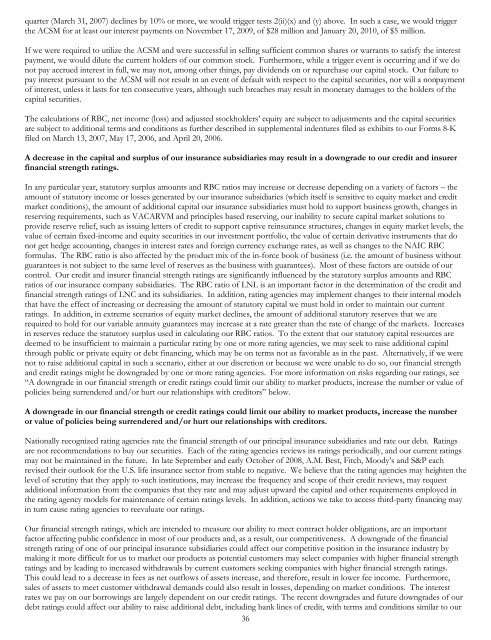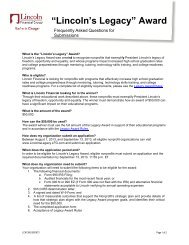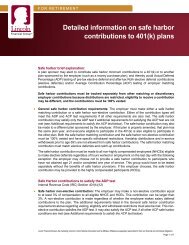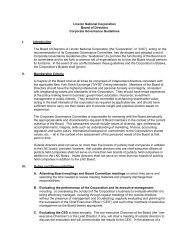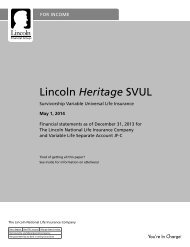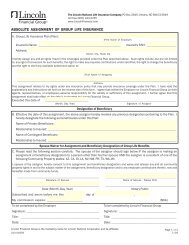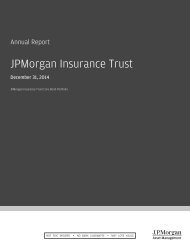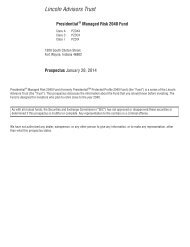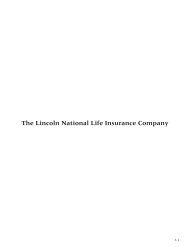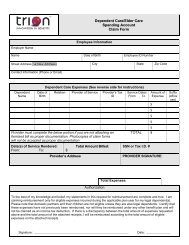2008 Annual Report to Shareholders - Lincoln Financial Group
2008 Annual Report to Shareholders - Lincoln Financial Group
2008 Annual Report to Shareholders - Lincoln Financial Group
You also want an ePaper? Increase the reach of your titles
YUMPU automatically turns print PDFs into web optimized ePapers that Google loves.
quarter (March 31, 2007) declines by 10% or more, we would trigger tests 2(ii)(x) and (y) above. In such a case, we would trigger<br />
the ACSM for at least our interest payments on November 17, 2009, of $28 million and January 20, 2010, of $5 million.<br />
If we were required <strong>to</strong> utilize the ACSM and were successful in selling sufficient common shares or warrants <strong>to</strong> satisfy the interest<br />
payment, we would dilute the current holders of our common s<strong>to</strong>ck. Furthermore, while a trigger event is occurring and if we do<br />
not pay accrued interest in full, we may not, among other things, pay dividends on or repurchase our capital s<strong>to</strong>ck. Our failure <strong>to</strong><br />
pay interest pursuant <strong>to</strong> the ACSM will not result in an event of default with respect <strong>to</strong> the capital securities, nor will a nonpayment<br />
of interest, unless it lasts for ten consecutive years, although such breaches may result in monetary damages <strong>to</strong> the holders of the<br />
capital securities.<br />
The calculations of RBC, net income (loss) and adjusted s<strong>to</strong>ckholders’ equity are subject <strong>to</strong> adjustments and the capital securities<br />
are subject <strong>to</strong> additional terms and conditions as further described in supplemental indentures filed as exhibits <strong>to</strong> our Forms 8-K<br />
filed on March 13, 2007, May 17, 2006, and April 20, 2006.<br />
A decrease in the capital and surplus of our insurance subsidiaries may result in a downgrade <strong>to</strong> our credit and insurer<br />
financial strength ratings.<br />
In any particular year, statu<strong>to</strong>ry surplus amounts and RBC ratios may increase or decrease depending on a variety of fac<strong>to</strong>rs – the<br />
amount of statu<strong>to</strong>ry income or losses generated by our insurance subsidiaries (which itself is sensitive <strong>to</strong> equity market and credit<br />
market conditions), the amount of additional capital our insurance subsidiaries must hold <strong>to</strong> support business growth, changes in<br />
reserving requirements, such as VACARVM and principles based reserving, our inability <strong>to</strong> secure capital market solutions <strong>to</strong><br />
provide reserve relief, such as issuing letters of credit <strong>to</strong> support captive reinsurance structures, changes in equity market levels, the<br />
value of certain fixed-income and equity securities in our investment portfolio, the value of certain derivative instruments that do<br />
not get hedge accounting, changes in interest rates and foreign currency exchange rates, as well as changes <strong>to</strong> the NAIC RBC<br />
formulas. The RBC ratio is also affected by the product mix of the in-force book of business (i.e. the amount of business without<br />
guarantees is not subject <strong>to</strong> the same level of reserves as the business with guarantees). Most of these fac<strong>to</strong>rs are outside of our<br />
control. Our credit and insurer financial strength ratings are significantly influenced by the statu<strong>to</strong>ry surplus amounts and RBC<br />
ratios of our insurance company subsidiaries. The RBC ratio of LNL is an important fac<strong>to</strong>r in the determination of the credit and<br />
financial strength ratings of LNC and its subsidiaries. In addition, rating agencies may implement changes <strong>to</strong> their internal models<br />
that have the effect of increasing or decreasing the amount of statu<strong>to</strong>ry capital we must hold in order <strong>to</strong> maintain our current<br />
ratings. In addition, in extreme scenarios of equity market declines, the amount of additional statu<strong>to</strong>ry reserves that we are<br />
required <strong>to</strong> hold for our variable annuity guarantees may increase at a rate greater than the rate of change of the markets. Increases<br />
in reserves reduce the statu<strong>to</strong>ry surplus used in calculating our RBC ratios. To the extent that our statu<strong>to</strong>ry capital resources are<br />
deemed <strong>to</strong> be insufficient <strong>to</strong> maintain a particular rating by one or more rating agencies, we may seek <strong>to</strong> raise additional capital<br />
through public or private equity or debt financing, which may be on terms not as favorable as in the past. Alternatively, if we were<br />
not <strong>to</strong> raise additional capital in such a scenario, either at our discretion or because we were unable <strong>to</strong> do so, our financial strength<br />
and credit ratings might be downgraded by one or more rating agencies. For more information on risks regarding our ratings, see<br />
“A downgrade in our financial strength or credit ratings could limit our ability <strong>to</strong> market products, increase the number or value of<br />
policies being surrendered and/or hurt our relationships with credi<strong>to</strong>rs” below.<br />
A downgrade in our financial strength or credit ratings could limit our ability <strong>to</strong> market products, increase the number<br />
or value of policies being surrendered and/or hurt our relationships with credi<strong>to</strong>rs.<br />
Nationally recognized rating agencies rate the financial strength of our principal insurance subsidiaries and rate our debt. Ratings<br />
are not recommendations <strong>to</strong> buy our securities. Each of the rating agencies reviews its ratings periodically, and our current ratings<br />
may not be maintained in the future. In late September and early Oc<strong>to</strong>ber of <strong>2008</strong>, A.M. Best, Fitch, Moody’s and S&P each<br />
revised their outlook for the U.S. life insurance sec<strong>to</strong>r from stable <strong>to</strong> negative. We believe that the rating agencies may heighten the<br />
level of scrutiny that they apply <strong>to</strong> such institutions, may increase the frequency and scope of their credit reviews, may request<br />
additional information from the companies that they rate and may adjust upward the capital and other requirements employed in<br />
the rating agency models for maintenance of certain ratings levels. In addition, actions we take <strong>to</strong> access third-party financing may<br />
in turn cause rating agencies <strong>to</strong> reevaluate our ratings.<br />
Our financial strength ratings, which are intended <strong>to</strong> measure our ability <strong>to</strong> meet contract holder obligations, are an important<br />
fac<strong>to</strong>r affecting public confidence in most of our products and, as a result, our competitiveness. A downgrade of the financial<br />
strength rating of one of our principal insurance subsidiaries could affect our competitive position in the insurance industry by<br />
making it more difficult for us <strong>to</strong> market our products as potential cus<strong>to</strong>mers may select companies with higher financial strength<br />
ratings and by leading <strong>to</strong> increased withdrawals by current cus<strong>to</strong>mers seeking companies with higher financial strength ratings.<br />
This could lead <strong>to</strong> a decrease in fees as net outflows of assets increase, and therefore, result in lower fee income. Furthermore,<br />
sales of assets <strong>to</strong> meet cus<strong>to</strong>mer withdrawal demands could also result in losses, depending on market conditions. The interest<br />
rates we pay on our borrowings are largely dependent on our credit ratings. The recent downgrades and future downgrades of our<br />
debt ratings could affect our ability <strong>to</strong> raise additional debt, including bank lines of credit, with terms and conditions similar <strong>to</strong> our<br />
36


